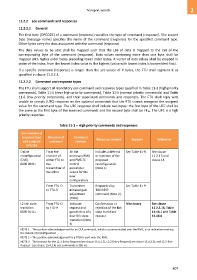Page 817 - 5G Basics - Core Network Aspects
P. 817
Transport aspects 2
11.2.2 eoc commands and responses
11.2.2.1 General
The first byte (OPCODE) of a command (response) specifies the type of command (response). The second
byte (message name) specifies the name of the command (response) for the specified command type.
Other bytes carry the data associated with the command (response).
The data values to be sent shall be mapped such that the LSB of data is mapped to the LSB of the
corresponding byte of the command (response). Data values containing more than one byte shall be
mapped with higher order bytes preceding lower order bytes. A vector of data values shall be mapped in
order of the index, from the lowest index value to the highest (value with lowest index is transmitted first).
If a specific command (response) is longer than the set values of P bytes, the FTU shall segment it as
specified in clause 11.2.2.3.
11.2.2.2 Command and response types
The FTU shall support all mandatory eoc command and response types specified in Table 11-3 (high priority
commands), Table 11-4 (near high priority commands), Table 11-5 (normal priority commands) and Table
11-6 (low priority commands), and their associated commands and responses. The FTU shall reply with
unable to comply (UTC) response on the optional commands that the FTU cannot recognize the assigned
value for the command type. The UTC response shall include two bytes: the first byte of the UTC shall be
the same as the first byte of the received command, and the second byte shall be FF16. The UTC is a high
priority response.
Table 11-3 – High priority commands and responses
Command and
response type Direction of Command
Response content Support Reference
and assigned command content
OPCODE
Online From the All the Includes a deferral See Table 11-9. See clause
reconfiguration receiver of necessary PMD or rejection of the 11.2.2.5 and
(OLR) either FTU to and PMS-TC proposed clause 13.
0000 00012 the control reconfiguration.
transmitter of parameter (Note 1)
the other values for the
new
configuration
From FTU-O Transmitter- Responded by See Table 11-9.
to FTU-R initiated gain TIGARESP
adjustment command (Note 2).
(TIGA).
L2 link state From FTU-O Indicates Confirmation or Mandatory See clause
transition to FTU-R request and rejection of the link 11.2.2.16, Table
0000 01112 parameters of a state transition 11-48.1 and Table
new link state request 11-48.6
transition (Note
3)
NOTE 1 – The positive acknowledgement for an OLR command, which is communicated over the RMC, is an indication marking
the instant of reconfiguration
NOTE 2 – The positive acknowledgement to a TIGA is sent over the RMC.
NOTE 3 – The timeout for the L2.1-Entry-Request (see clause 13.4.1.2), L2.2-Entry-Request (see clause 13.4.2.2), and L2.2-Exit-
Request (see clause 13.4.2.4) eoc commands is 200 ms.
807

